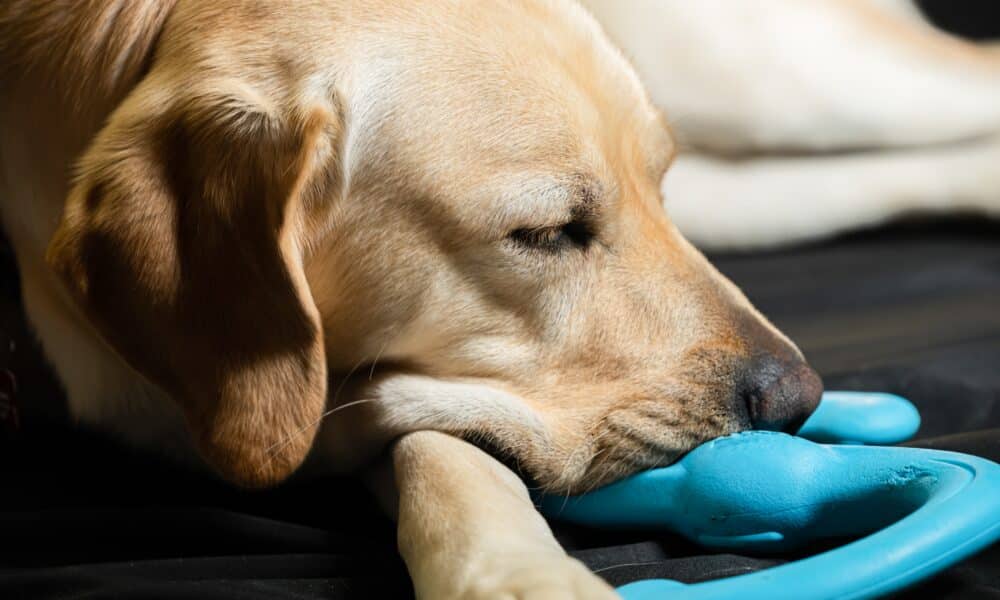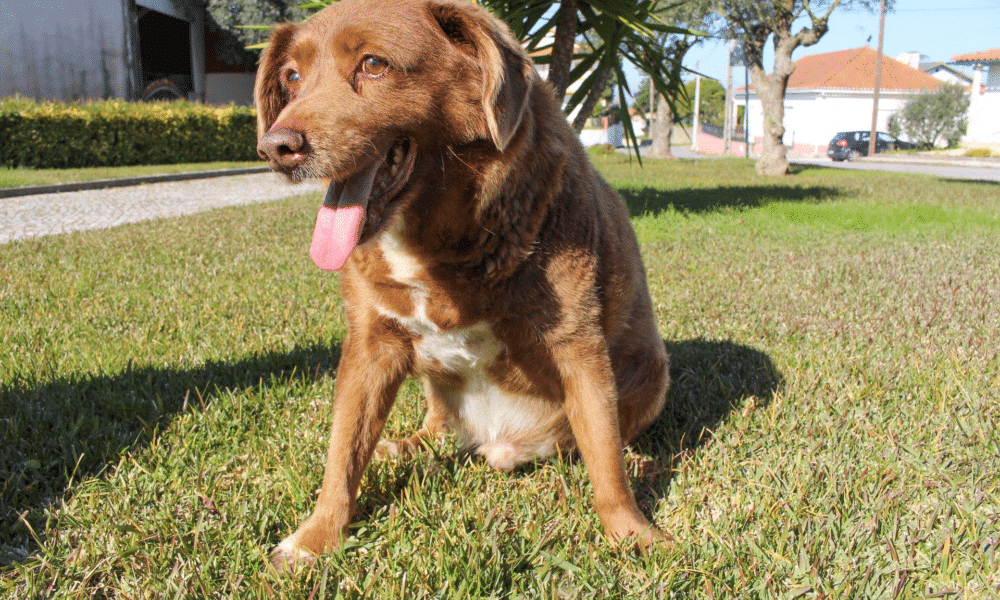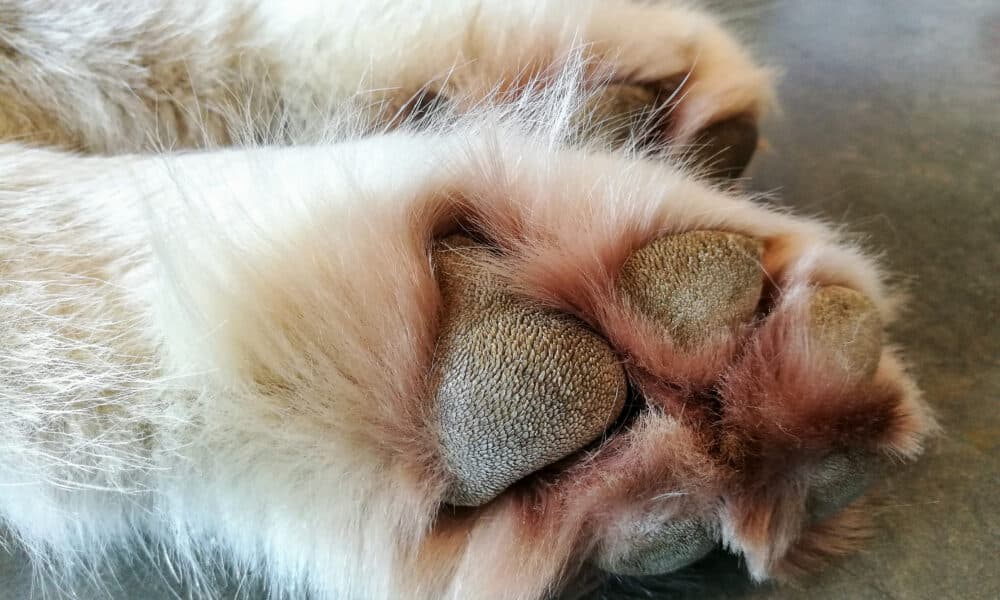
Does your dog have hair paw pads? If yes, then he might be suffering from dog paw hyperkeratosis. If you look closely, you’ll see that the “hair” on your furry friend’s paw pads is not actually hair, but dry skin.
Dog paw hyperkeratosis, also known as hairy dog feet, is a skin condition that generally affects the paw pads and can cause discomfort and pain for our furry friends.
Continue reading below for a deep dive on dog paw hyperkeratosis, what causes it, what its symptoms are, how to treat it and how to prevent it altogether.
What Is Hyperkeratosis?
Hyperkeratosis is a skin condition that causes the skin to become thick and hard. It stems from the body’s overproduction of a protein called keratin. And both humans and dogs can suffer from it. In dogs, it can affect their nose or paw pads.
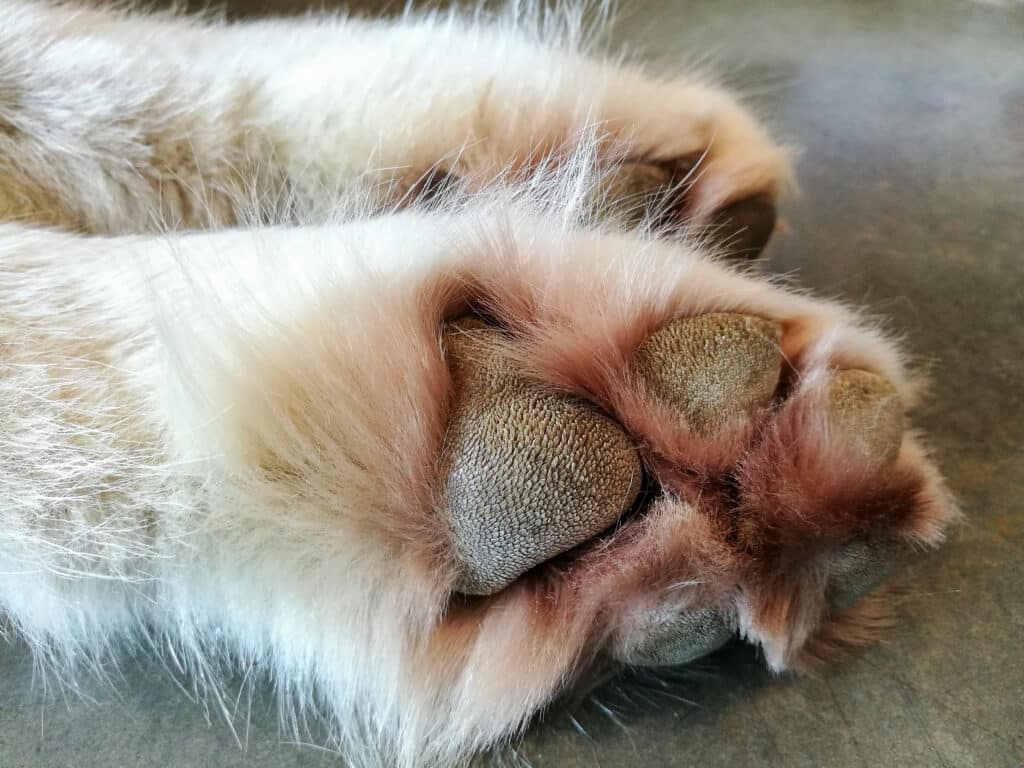
If you’re unfamiliar with keratin, it’s a protein that makes up hair, nails, horns, hooves and claws. So, when your dog’s body produces too much keratin, it can lead to hard, dry and crusty material on the dog’s paw and sometimes, nose.
While it can grow on dogs’ nose and ears, it can be most commonly found in dogs’ paw pads. And when it develops, it looks like hair that is growing out of your dog’s paws, hence the name hairy dog feet.
Is Paw Hyperkeratosis Painful For Dogs?
When it first develops, dog paw hyperkeratosis isn’t painful. But if left untreated, it can be. Hyperkeratosis can progress to a point where your dog may be unable to walk or stand due to the pain associated with the skin condition.
Furthermore, as it progresses, it can bring discomfort to your dog. So it’s best to always check your dog’s paw for extra hardened and dry skin, especially if it’s a senior dog.
Is Paw Hyperkeratosis Dangerous and Life Threatening?
Fortunately, dog paw hyperkeratosis is generally not dangerous and life threatening. However, in some cases, it can lead to infections or other complications if you do not address it immediately and properly.
Dog Paw Hyperkeratosis Causes
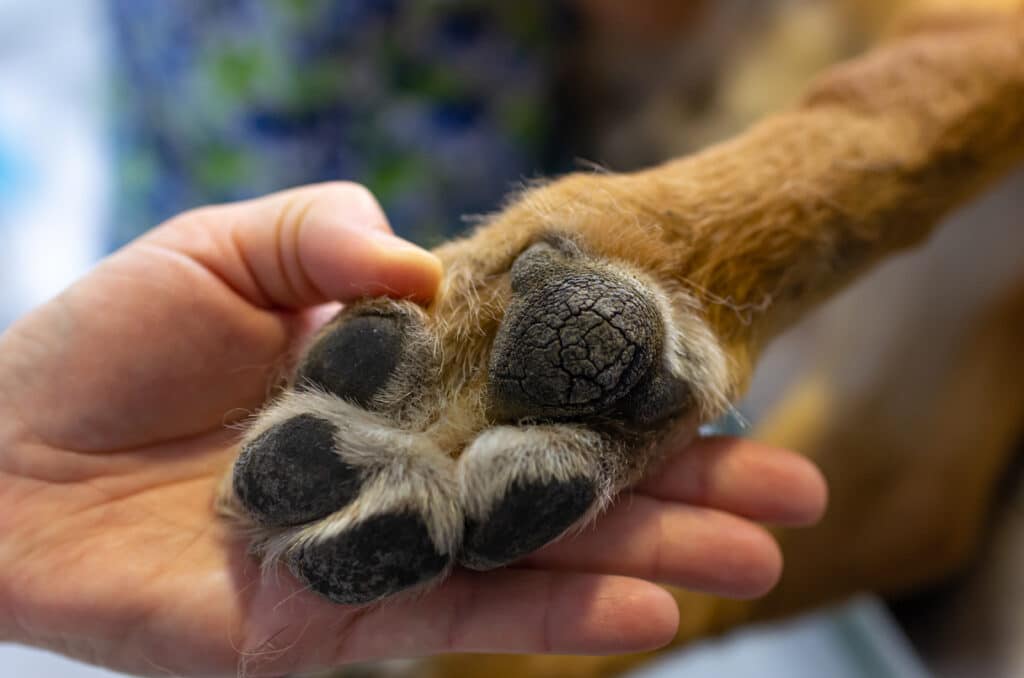
Dog paw hyperkeratosis is not contagious, but there are a variety of factors that can cause it. And they’re the following:
1. Genetics
Dog paw hyperkeratosis is a hereditary condition. Meaning many dogs are genetically more prone to it than others. For example, Labradors can suffer from it because of a genetic defect called nasal parakeratosis.
2. Age
Contrary to what happen to us human beings, a dog’s skin thickens as they age, especially at the pressure points like paws. And this causes the formation of calluses that leads to dog paw hyperkeratosis.
3. Canine Distemper
One of Canine Distemper’s symptoms is dog paw hyperkeratosis. This life-threatening disease causes the thickening of the skin on the dog’s foot pads and sometimes even on the nose. That’s why canine distemper is sometimes referred to as hard pad disease.
It’s important to note that dogs that have been properly vaccinated against Canine Distemper as puppies are less prone to the skin condition.
4. Pemphigus foliaceus
This is a very common autoimmune disease found in middle-aged to older dogs. And it can make way for the development of dog paw hyperkeratosis.
5. Zinc deficiency
Some dog breeds are prone to zinc deficiency because they cannot naturally absorb this mineral through their food and other means. In turn, this can lead to zinc responsive dermatosis, which then turns to dog paw hyperkeratosis.
6. Leishmaniasi
This is a parasitic diseases caused by sandfly bites. And one of this disease’s signs is dog paw hyperkeratosis along with muscle pain, joint inflammation and swelling of the testicles.
Dog Paw Hyperkeratosis Symptoms

Hyperkeratosis in dogs, as mentioned above, affects a dog’s paws or nose. In rare cases, it can grow in other body parts like the elbows or ears. However, it is more commonly found in a dog’s paw pads.
When it first develops, dog paw hyperkeratosis looks like hair that is growing out of a dog’s paw pads. And as it progresses, the skin gets thicker, harder and crustier.
Aside from the dry, crusty and thick layer of skin, other symptoms of dog paw hyperkeratosis include:
- Cracks, fissures and bleeding
- Loss of skin color in the affected area
- Frequent licking of paws
- Limping
- Reduced physical activity
- Secondary infections
Like any other health problem, it’s important to detect dog paw hyperkeratosis as early as possible. This will help you immediately give your dog the proper attention and care it needs.
So, if you notice any signs of these symptoms in your dog, visit your dog’s vet immediately.
Dog Paw Hyperkeratosis Treatment
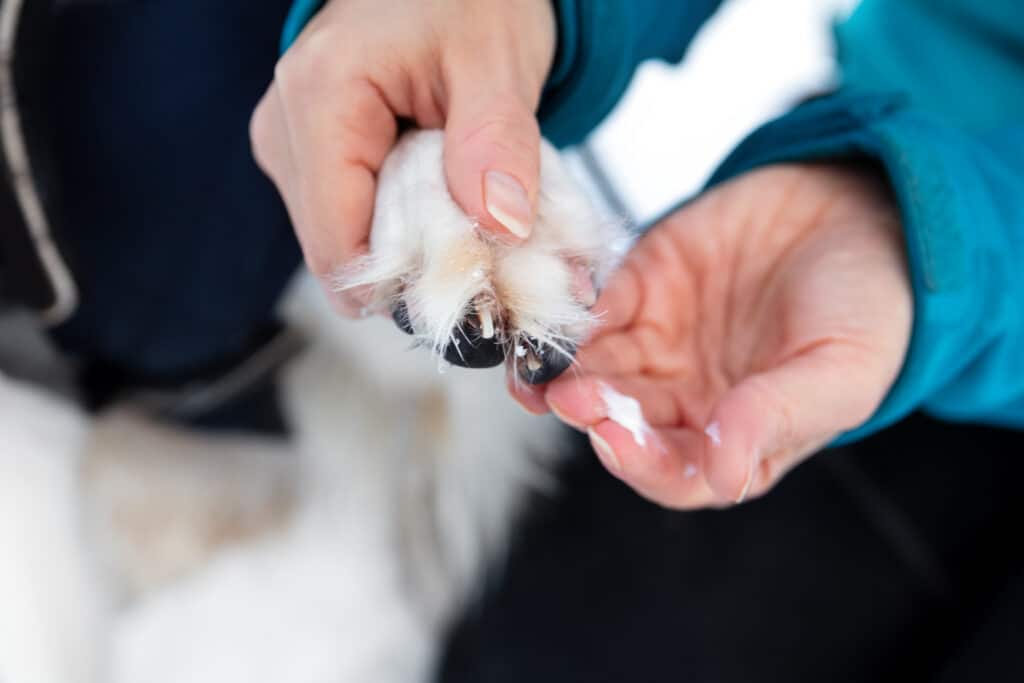
Unfortunately, once your dog gets hyperkeratosis, it’s unlikely to go away. And at the moment, there is no known cure for the condition, only ways to manage it.
Here are a few options you can opt for to help manage dog paw hyperkeratosis:
1. Treat The Underlying Disease
As mentioned earlier, dog paw hyperkeratosis is caused by a number of other health issues. If your dog has an underlying issue that’s causing the skin condition, the treatment will focus on treating that issue.
So for example, if your dog has pemphigus foliaceus, your vet will treat it with immunosuppressive medications.
2. Trim The Excess Skin
To ensure that hyperkeratosis doesn’t make your dog uncomfortable, it’s best to go to your vet to have the excess skin trimmed. And if you’re confident you can do it on your own at home, you can ask for the vet to show you how to do it properly and safely.
Do not attempt to do this without a vet’s approval and guidance. Because if you do, it can do more harm than good.
3. Soak Your Dog’s Feet In Epsom Salt
A home remedy that you can easily do to help manage mild dog paw hyperkeratosis at home is through feet soaking.
Soaking your dog’s feet in warm water with Epsom salt for 15 minutes will help soften the excess keratin. Furthermore, the moisture from the soak won’t only soften the cracked skin but also relieve the pain caused by the skin condition.
After the feet soak, make sure to dry your dog’s paw thoroughly to prevent secondary infections.
4. Apply Ointment To Paws
A balm, ointment or butter designed for dog paws is an affordable yet effective way to manage mild dog paw hyperkeratosis.
Dog paw balms help moisturize the excess dry skin and alleviate your dog’s discomfort while walking or doing any physical activity. Furthermore, applying this two to three times a day can help improve your dog’s paws condition faster.
5. Consult Your Veterinarian
In severe cases, it would be best to ask your vet for the best course of action. Depending on the severity of the condition, they may prescribe topical or oral medications, moisturizers and exfoliant for secondary infections.
Dog Paw Hyperkeratosis Prevention
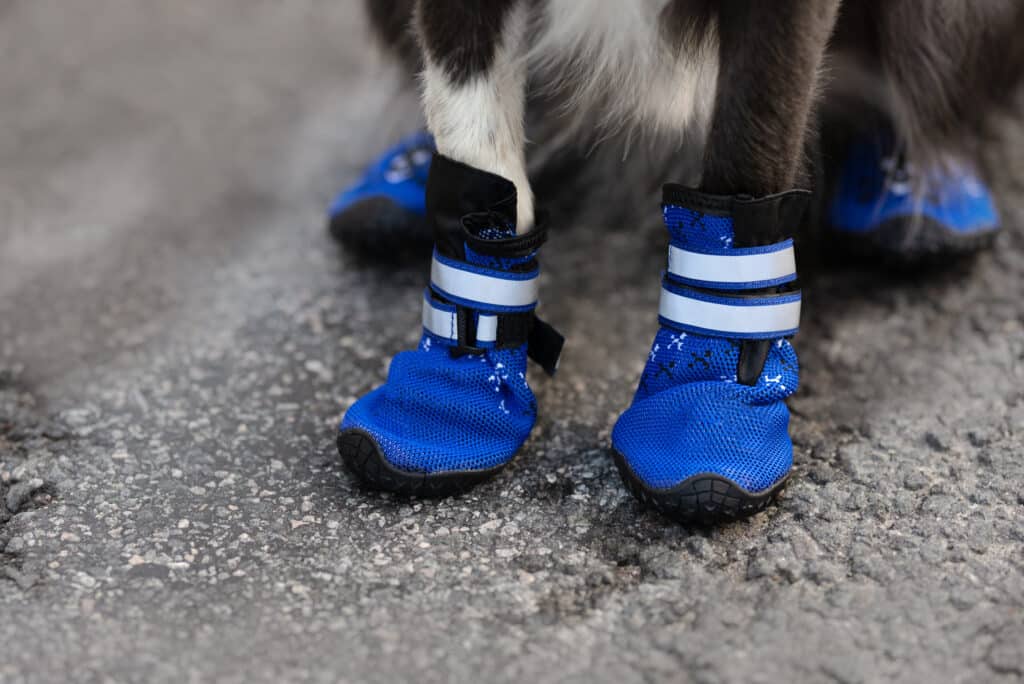
As it stands, there is no way to prevent hereditary hyperkeratosis. However, there are a few ways to prevent the non-genetic type.
Here are a few tips to lessen the chances of the skin condition ever developing on your dog’s paw pads:
- Regularly check your dog’s paws. It’s much easier to heal and manage hyperkeratosis if you can detect it during its early development.
- Use a moisturizing balm. Even though your dog’s paw pads aren’t dry and crusty, it’s always best to keep them moisturized all the time. This way, they become less prone to hyperkeratosis.
- Clip your dog’s nails. Doing this helps keep your dog’s paw clean and healthy. Furthermore, clipping your dog’s nails ensures that your dog’s nails won’t scrape the ground and cause accidents.
- Use dog socks or boots. When going on a walk, it’s best to keep your dog’s paws clean and away from rough surfaces. The less irritated your dog’s paw pads are, the better.
- Vaccinate your dog against Canine Distemper. As mentioned above, dog paw hyperkeratosis is one of the symptoms of this life-threatening disease. So, make sure to vaccinate your dog against it.
Conclusion
Dog paw hyperkeratosis might not be life-threatening or dangerous, but it’s still a health condition that should be taken seriously.
If not managed immediately and properly, it can cause major discomfort and pain for dogs, especially the older dogs, that can hinder their daily activities. And we hope that this beginner’s guide can help you manage this skin condition so your dog can continue living a great and healthy life!

